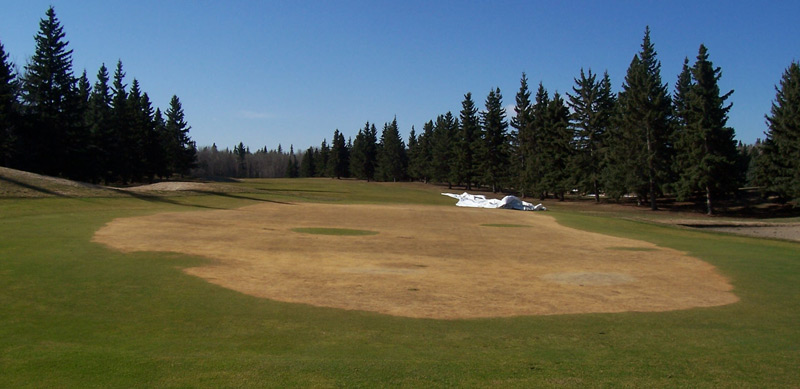
The sixth green at Glendale Golf & Country Club in Edmonton, Alberta, in spring 2008, after winter covers had been pulled back. The dead turf was caused by oxygen depletion and the buildup of toxic gases under the cover.
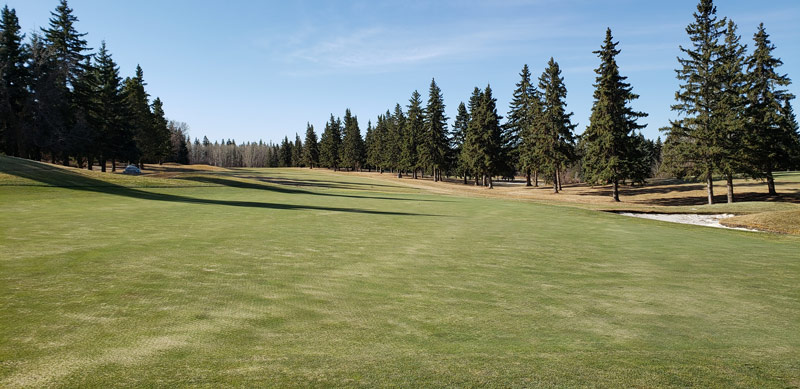
The Glendale’s sixth green in April 2021, after removal of an improved winter cover system. Photos courtesy of Chris Prodahl
Winters north of the 49th parallel are long and brutal, and this is especially true for Canada’s prairie and mountain provinces. In Alberta, winters can last as long as seven months, and, on average, snow cover can last 150 to 200 consecutive days. After the snow melts and the frost comes out of the ground, it takes 20 to 25 days before the turf begins actively growing. The window for the area’s golf course superintendents to produce excellent conditions is always small. Turf damage is inevitable, but like many in the industry and around the world, Alberta superintendents try to control as much as possible (given the financial ability) throughout the winter months.
I’ve worked at Glendale Golf & Country Club in Edmonton, Alberta, since 2016. Prior to that, superintendent Daryl Asher had overseen the 18-hole course for 27 years.
Rewind to the winter of 2006-2007: Asher decided to install impermeable covers on top of closed-cell foam on all greens, with the goal of reducing winter damage to the annual bluegrass putting surfaces. The golf course maintenance team installed the covers on unfrozen turf in late October, just before a deep, heavy, permanent snow cover. The turf injury the following spring was severe — 90% to 95% of each of putting surface was lost. The injury had been caused by anoxic conditions from the lack of air movement, which resulted in depleted oxygen under the covers. Recovery was lengthy and costly. However, Asher found that 3 to 5 meters around the edge of each green came out of winter healthy. These healthy areas were the result of airflow coming in and out from the edges of the tarps.
In the fall of 2007, Asher opted to install a similar system on greens, but with a few key modifications to reduce the chances of anoxic conditions developing. He switched from closed-cell foam to bubble wrap and installed collapsible polyethylene ventilation tubes under the bubble wrap. The tubes were then attached to raised drainage tile outside the cover to form a manifold, allowing air to be introduced and circulated with leaf blowers. The team installed temperature sensors, and, to monitor gas concentrations throughout winter, a carbon dioxide and oxygen sensor would be connected to a polyethylene tube extending out from the center of the green.
Asher’s new setup worked — there was no turf injury anywhere beneath the tarps come spring — and this is the system we still use today to protect The Glendale’s now-bentgrass greens from winter damage.
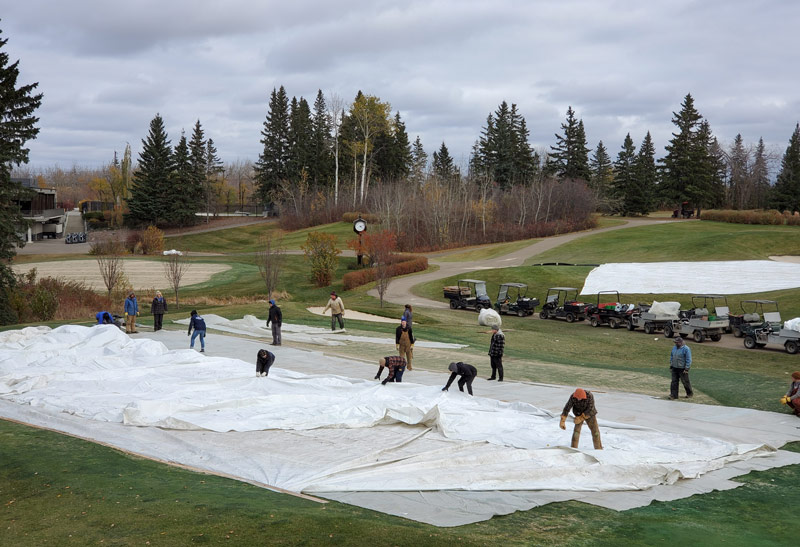
Installation of turf cover materials on The Glendale’s ninth green in fall 2020.
The components of the system are as follows:
- Installation of a clear, quarter-inch polyethylene tube to transport carbon dioxide/oxygen out of the tarp system. The single tube runs to the middle of the green. We take carbon dioxide and oxygen measurements during winter by connecting a monitor to this tube.
- Installation of temperature sensors, three per green, running to the front, center and back of each green.
- Installation of three to four (depending on green size) clear, polyethylene collapsible ventilation tubes that run to each section of the green. Each of these tubes is connected to 4-inch-diameter drainage tile that comes out from underneath the tarp, and a leaf blower is then connected to the drainage tile either via duct tape or a tarp strap. The tubes inflate during ventilation and deflate after the air has been dispersed.
- Installation of bubble wrap on top of all sensors and collapsible tubing, covering the entire green and, in some areas, extending to the collars.
- Installation of the impermeable tarp on top of the bubble wrap.
- On high areas and other areas around the tarp where water may be able to run underneath it, we nail down 4-inch-wide plywood slats to prevent any water from entering.
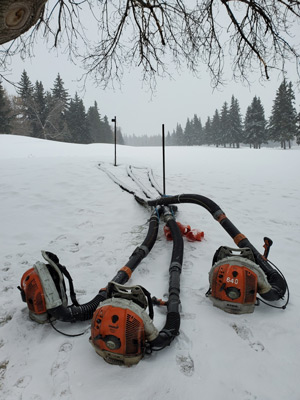
Right: Backpack blowers hooked up to 4-inch-diameter drainage tile supply air under a tarp.
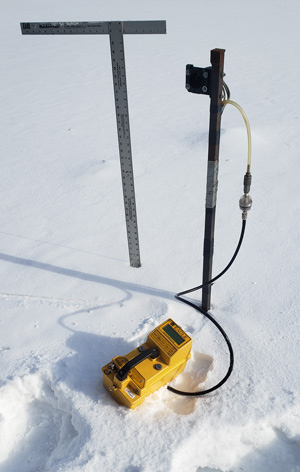
Right: A carbon dioxide and oxygen monitor attaches to the quarter-inch polyethylene tube that extends to the center of a green.
Under perfect circumstances, it takes The Glendale golf course maintenance staff — typically 12 crew members — three full days to install all materials for the current winter cover system on all greens. We used to worry that the ground had to be frozen before we installed the tarping, but this isn’t always possible when permanent snow cover is in the forecast. Fortunately, in our experience, tarp installation can happen anytime and the system will still work well, but we do try to avoid tarping in higher temperatures (greater than 8 degrees C).
Editor’s note: Is it crown hydration or anoxia? Would a permeable or impermeable cover be best? Match injury to defense and get more know-how on seeing turf through winter in Winter turf damage and turf covers: A guide.
Back in fall 2008, the Prairie Turfgrass Research Centre, which is part of Olds College in Alberta, teamed up with The Glendale to conduct a study that assessed the efficacy of various ventilation systems under impermeable covers for preventing anoxia injury. The project lasted over the next three winters, and through it, a relatively simple system for monitoring carbon dioxide and oxygen under the covers was developed. (Read much more about it in the study, Evaluation of ventilation systems under winter covers to prevent injury from anoxia on annual bluegrass greens.)
For the study duration, ventilation would occur under the tarps whenever carbon dioxide levels were greater than 5% or oxygen levels were less than 10%. These levels maintained acceptable turfgrass quality.
Today, we take carbon dioxide and oxygen readings under each tarp every week during the winter months. The readings fluctuate depending on the current conditions (temperature and wind). As external temperatures rise, soil microbial activity increases, which raises our CO2 levels and depletes the oxygen levels. Greens with internal drainage (built to USGA specifications) are less active during the winter months and, based on tracking of clipping yields, are also less active during summer. We usually blow air under these tarps just three to four times per winter. In contrast, greens with no internal drainage or poor subsurface or surface drainage (push-up greens) are more active during winter and summer. The Glendale has four greens with these characteristics, and they grow faster throughout the golf season and require more attention during winter. We’ve found that we need to blow air underneath these tarps twice a week.
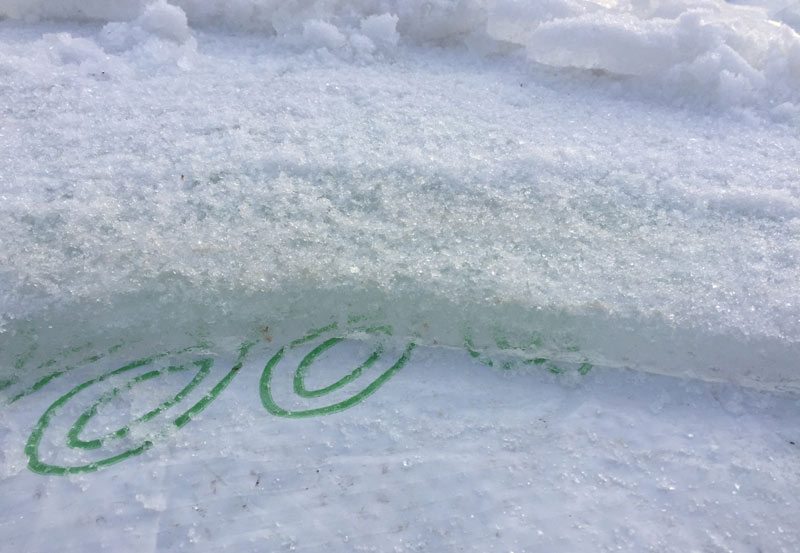
Ice buildup on an impermeable cover after a winter rain event.
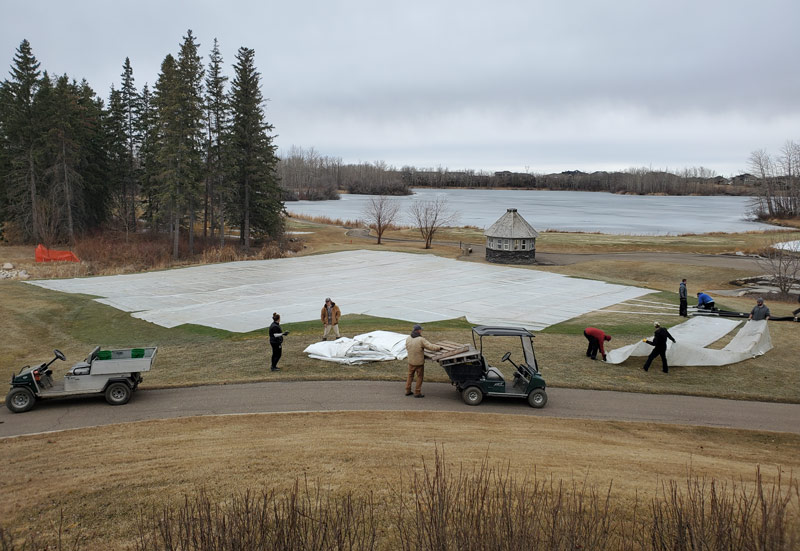
The Glendale’s maintenance team removes the tarp from the course’s practice green in April 2021. Removal of all winter protection materials takes the staff two and a half days. Photo by Michael Davis
The timing of when air is blown under the tarps is also critical. Our goal is to blow air underneath the covers first thing in the morning, when external temperatures are below freezing, to avoid creating ice buildup at the manifolds and on top of the tarps when the tarps expand and then settle. The warmer the external temperature when air is introduced under the tarp, the more likely that ice will form.
Editor’s note: A Minnesota grounds crew got creative to revive a winter-decimated green in just days. Check out Winter turf damage: The green in the bubble to find out how they devised the structure that produced the remarkable results.
From 2017 through 2020, the Edmonton area has had significant rain events in November on top of already frozen ground without snow cover. Without the impermeable tarps, The Glendale would, without a doubt, have had ice form on our putting greens. The impermeable covers have helped many clubs, including ours, avoid turf loss. The shorter golf season up north makes it very important that we come out of the gates with healthy greens and don’t spend the first month playing catch-up, and our tarping system is critical to accomplishing that.
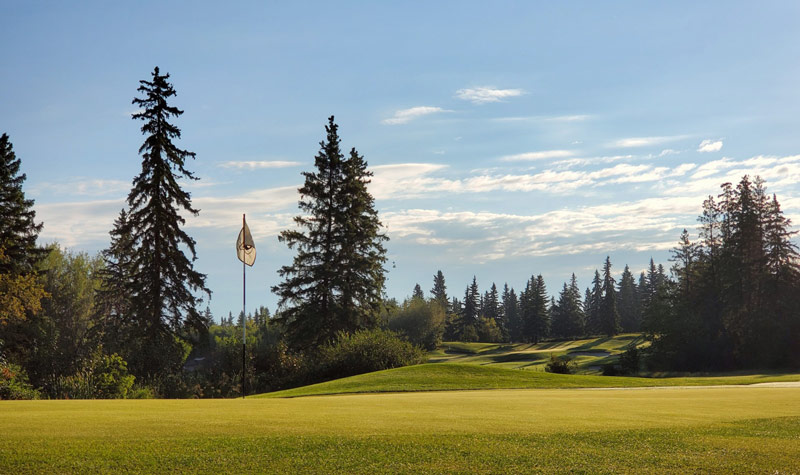
Glendale Golf & Country Club in Edmonton, Alberta, has hosted the PGA Tour Canada’s Edmonton stop five times, most recently in 2016. The private course, designed by Norman Woods, features bentgrass greens and Poa annua/bluegrass fairways and tees. Photo by Michael Davis
The tarping system continues to evolve as new ideas emerge and new products come to market. Many clubs around the Edmonton area have switched from bubble wrap (which is tough to install in the wind) to an Enkamat (recycled rubber) product that can be easily handled in windy conditions. These superintendents have had great success with this over the past five years, and we’re starting to move in that direction here at The Glendale.
Fellow superintendents who’d like further information: Feel free to email me.
Chris Prodahl is the golf course and property manager at Glendale Golf & Country Club in Edmonton, Alberta, where he has worked for five years. He is the current president and a 15-year member of the Alberta Golf Superintendents Association and a 16-year member of the Canadian Golf Superintendents Association. Prodahl is also a six-year member of GCSAA.